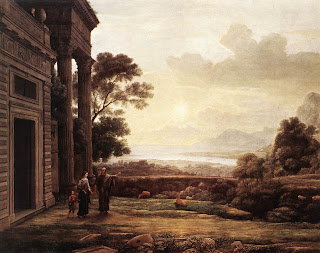The Fall, 2006
Oil on Canvas 153 x 250cm
Saatchi Gallery, London
19 August 2010
I must admit I was a little disappointed with the Newspeak: British Art Now (Part 1) exhibition at the Saatchi Gallery, there was certainly some quality work, but overall it lacked the impact of the Sensation exhibitition at the Royal Academy in 1997.
One of the artists that did catch my eye was 47 year old Cornwall based painter, Ged Quinn. Several of Quinn’s large landscapes and still lives shared a room with Sigrid Holmwood’s pastich fluorescent paintings of early Van Gogh. Quinn draws on an even earlier source of inspiration, the feathered landscapes of Claude Lorrain.
“The Fall” is based on the Claude’s Arcadian setting for his 1668 painting “The Expulsion of Hagar” to which Quinn has added poet and dramatist Antonin Arnaud falling from the sky towards a ramshackle burnt out shed. The painting is clearly layed with meaning and the references from recent history becomes “blots” on the Romantic styled landscape. The shot down Antonin Artaud, the creator of the Theatre of Cruelty, is swathed in combat-plane camouflage refers to Lucifer's fall from grace in Milton's Paradise Lost. The shed is Thomas Edison's first purpose-built film production studio, the “Black Maria”, and it is decorated with Artaud's work. I must admit to a weakness to spending time trying to work out the references in his paintings rather than trying to decipher what the whole might mean.
In the Theatre of Cruelty, Artaud was trying to revolutionise theatre - figuratively burn it to the ground so that it could start again. He was trying to connect people with something more primal, honest and true within themselves that had been lost for most people. He believed that text had been a tyrant over meaning, and advocated, instead, for a theatre made up of a unique language that lay halfway between thought and gesture. This has interesting parallels with the theory surrounding the death of painting and provides us with the link to the film industry, where everything is false. Artaud believed in physical expression, something lacking in Claude’s “old fashioned” picturesque landscape painting. It is typical of the mediated vision of the ideal landscape that we all have in our mind's eye and is no longer radical, any power it once had has been bled away by mechanical reproduction.
A knowledge of the subject of the original Claude painting may provide a different interpretation, it shows Hagar and Ishmael being banished into the desert of Beersheba by Abraham. The original is set in the cool light of morning and is paired by a second painting (a pendant) set in an evening desert landscape when the archangel Michael appears to the sorry couple and leads them to a well, saving them from dying of thirst. In Quinn’s painting centuries have passed, Hagar and Ishmael long gone, the temple derelict and fragments of columns and pediments lying in the foreground, but the cool light of dawn remains. Is this the truth that Quinn wants to represent in his “Theatre of Cruelty”?
©blackdog 2010


















